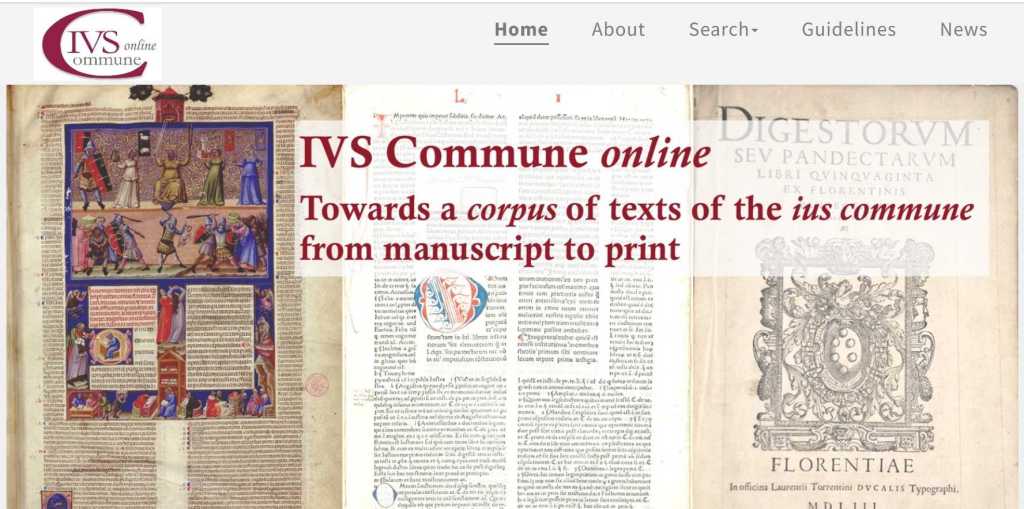
Finding and describing sources can be a hard task. The efforts of scholars who start creating any kind of repertory face many challenges. For tracing manuscripts concerning the medieval ius commune some online repertories already exist. In IVS Commune online, a new project at the Università di Torino, not just manuscripts will be presented, but also early printed editions of the works of late medieval lawyers and other legal texts. The project will cover the period 1350-1650. In 2021 the start of work on this project was announced, and now the first results can be searched online. What are the core aims and distinctive qualities of the repertory? What does it bring for scholars, and what wishes can be expresses to strengthen it? In this post I would like to present some impressions of my first forays into this interesting repertory.
Legal texts in print and manuscripts
Two years ago, during the first online conference of Ius Illuminatum in September 2021, concisely reported upon here, Maria Alessandra Panzanelli Fratoni presented not only IVS Commune Online, but also a closely related project at the Italian MANUS manuscript portal called MANUS Iuridica. In fact visiting MANUS this month reminded me about the project in Turin, and it is by all means wise to devote here some space to it. I revisited the MANUS portal in a search for medieval manuscipts in Italy. Somehow I did not immediately think about the recent integration of the CODEX project for medieval manuscripts in Tuscany into the multiple catalogue search function at the Mirabile portal. The portal Nuova Bibliotheca Manoscritta for medieval manuscripts in Lombardy and the Veneto brings you not only a regional catalogue, but also a digital library. Manoscritti Datati d’Italia is another research tool fit for inclusion here.
The MANUS project explicitly builds on the pioneering overview by Gero Dolezalek and Hans van de Wouw, the Verzeichnis der Handschriften zum römischen Recht bis 1600 (4 vol., Frankfurt am Main 1974), now available online as the database Manuscripta juridica at a server of the Max-Planck-Institut für Rechtsgeschichte und Rechtstheorie. In 1970 Dolezalek and Van de Wouw had to warn their readers that the descriptions given in the repertory in most cases did not stem from personal inspection. Fifty years ago a world with a plethora of online library catalogues, let alone digital access to medieval and Early Modern manuscripts, was still far away. Dolezalek promised an update with descriptions of canon law manuscripts, but alas no update of Manuscripta Iuridica has been performed since 2017.
The clear difference at IVS Commune online from the outset is the wish to add also printed editions of medieval legal texts. Panzarelli and her colleagues use data from incunable editions stored in the Text-Inc project of the Bodleian Libraries, Oxford. Among other online resources that will be used to prepare the bibliographical data for authors, texts and editions is the European meta-catalogiue for Early Modern printed works, the Heritage of the Printed Book database (HPB).
Using IVS Commune online
The portal of IVS Commune online comes with three search interfaces, respectively for texts, names, and works. The first interface for texts contains in fact also search fields for names and works. semantic indexing, bibliographical data, and information concerning copies and references. The search interface for names shows you at the start an overview of names with cross-references to standardized versions of names. I could not help seeing immediately a nice example of two lawyers wrongly assigned under one name, Accursius (ca. 1182-1260) and his son Franciscus (1225-1293) are not identical. Luckily this seems to be an isolated mistake. For each author a core selection of data is given. In my opinion adding references to authority files for persons would be truly helpful, but building first a foundation is surely right, and entries in both Text-Inc and the HPB database are used as a base fo the earliest editions.
The interface for works presents the titles of texts as found in existing manuscripts and printed editions, and here, too, you see at the start an alphabetical overview combined with a search field. This means some titles will not be given in Latin, but in Italian, Spanish or other languages. An entry starting an alternative title with “Also known as” has escaped attention, but it helps you to be aware of alternative titles.
The section with guidelines is still empty. The news section alerts you to a recent workshop of the international Héloïse network for the history of universities, held at Turin on October 25 to 27, 2023 on digital approaches to the cultural heritage of universities.
In my view it is still a bit early to state already much about the qualities of IVS Commune online. Despite the presence of many names and titles the database seems yet rather empty when you know about the variety of works preserved in manuscripts. However, in its current phase you can see quite distinctly its qualities for the data concerning printed works. It looks very much like only the information from the Text-Inc project in Oxford has been entered into the database. Anyway focusing on printed books transmitting legal texts is a welcome addition to the more traditional focus on manuscripts with these texts.
Repertories, catalogues and standards in context
The alphabetical list of names reminded me of something else, too. The list starts with a number of Arabic authors. When studying Arabic texts and translations it is necessary to be very clear what exactly you are studying in order to prevent confusion. Already the fact Arabic translations and adaptations of texts exist, sometimes even in several versions, should serve as a reminder it pays off in the end to provide a lot of bibliographical information. The threefold entrance of IVS Commune online for texts, works and names looks to some extent akin to the multi-layered description in the Library Reference Model (LRM) proposed by the International Federation of Library Associations (IFLA).
My knowledge of this model stems from a library catalogue pioneering the implementation of LRM and related standards, for example RDA (Resource Description and Access). The Alkindi catalogue of the Institut Dominicain d’Études Orientales (IDEO) in Cairo has as one of its aims the provision of data in order to serve as a virtual reference tool for Arabic studies, close to becoming even an union catalogue. The Alkindi catalogue with a multilingual interface presents information about copies as a term for actual objects containing information, manifestations being specific publications, expressions being specific editions and works, the intellectual product. Persons, too, can be identified in their specifc roles and connectied to each other, in other words, matters concerning authority files are present, too.
Faceted research becomes feasible when using such standards. The standards combined here surpass the levels or ordinary alphabetical and systematical description for which international standards exist. At the library portal of the Diamond platform the Alkindi catalogue itself is part of a consortium with eleven libraries, including the Biblioteca Apostolica Vaticana and several libraries in Cairo, Paris and even in Erbil, Irak. In my view IVS Commune online is moving on a similar road, and of course this means facing huge challenges to implement all facets succesfully. The team of IVS Commune online (ICo) indeed expresses its aim to offer both data for content analysus and bibliographical description, and – most importantly – information for text identification. The ICo team has addressed this subject in a number of publications. I had expected to find a reference to the use of a particular standard for the description of (medieval) manuscripts, too.
Thanks to the Hazine blog for Arabic studies I encountered the Alkindi catalogue some years ago. The online magazine The Digital Orientalist can serve as a fine starting point for gaining insight into the role of digital humanities for Arabic and Islamic studies.
Whatever you think of the aims behind projects such as ICo, MANUS Iuridica and Manuscripta juridica, and also about new bibliographical standards, in this case they do at least deal with a very particular situation for the study of medieval legal systems, be they the ius commune, the common law, customary law or regional law. They express a conciousness that only for a limited number of medieval legal texts modern critical editions are available. Scholars delving into medieval law have to become really close to their sources. Luckily repertories exist for many disciplines dealing with medieval sources. The SIEPM society for the study of medieval philosophy has created a most useful and wide overview of (online) repertories for medieval manuscripts and texts, mentioning also national portals for medieval manuscripts.
However, for medieval law only a number of periods and subjects are covered in repertories. For medieval canon law only the period until 1234 is covered in the manuscript repertories created by Stephan Kuttner, and by Lotte Kéry for the period 400 to 1100. The repertory of medieval legal manuscripts in the Vatican Library has not been completed; only two volumes have been published. To redress the balance, manuscripts concerning the medieval and Early Modern common law can be traced thanks to the repertories and catalogues edited by Sir John H. Baker. Ulrich-Dieter Oppitz included even images of manuscript fragments in his repertory of manuscripts for German regional law (Rechtsbücher).
Efforts to bridge such gaps are most welcome. I admire the courage and stamina of scholars who start or continue such projects, and my remarks do not matter that much in view of the tasks they have set themselves to serve the scholarly community. The ICo project is clearly in an early phase. It deserves attention and support helping the team to achieve its aims. Any repertory worthy of its name has its qualities and limits, be it print or online. This short post will serve its purpose when it inspires anyone to support work on modern repertories for the manuscript and print tradition of medieval law in its many forms.
A postscript
At Archivalia Klaus Graf wondered very much on November 27, 2023 about the inclusion by ICo of a work concerning the election for the German emperor Maximilian in 1486. I agree some pruning of works included at ICo is necessary. He also criticised my reference to the list of online manuscript repertories created by the SIEPM, in his view simply outdated, however, without pointing to a better list of such repertories. Graf’s own list of relevant repertories was last updated in 2018. Among the repertories which will disappear quite soon is the German portal Manuscripta Mediaevalia, to be taken down from December 11, 2023 onwards. As a successor the Handschriftenportal is indicated.
Meanwhile I will consider the feasability of creating an overview of repertories for distinct manuscript genres, perhaps combined with a handlist of national repertories for (medieval) manuscripts. It can do no harm to look at the splendid overview of manuscript catalogues and its section Special Interests created and maintained at the Universität Kassel, most probably the resource Klaus Graf would recommend. At my website I created in December 2023 a fairly concise overview of manuscript repertories, with due caution about its limits and with gratitude for other existing overviews. The CERL consortium, too, offers a fine overview of repertories and related websites for manuscript research (PDF).
In 2022 Gero Dolezalek gave an overview of the projected update for Manuscripta juridica in 2023, and he offered a similar overview of the 2017 update. Sometimes non-juridical works are bound with legal works.


